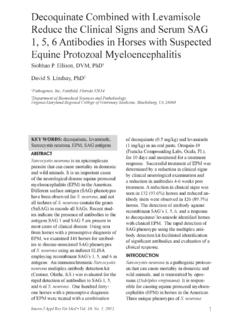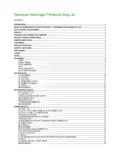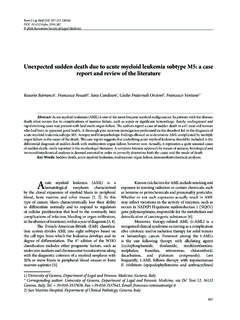Transcription of Evaluation of Mitoxantrone with Piroxicam as First Line ...
1 Vol. 11, No. 1, 2013 Intern J Appl Res Vet WORDS: KeywordsABSTRACTC arcinomas of the prostate in dogs are a heterogeneous group of aggressive cancers that collectively carry a poor prognosis. The aim of this retrospective study was to evalu-ate the efficacy of using Mitoxantrone along with Piroxicam for the treatment of carcino-mas of the prostate. Survival time, time to treatment failure, subjective and objective responses, prognostic indicators, and toxic-ity were evaluated. Twenty-five dogs were included in this study. Metastatic disease was diagnosed in 56% of dogs and 72% at the time of death. Seventy-four percent of dogs had a subjective improvement in clini-cal signs with the majority of dogs respond-ing within 30 days. No objective responses were noted.
2 Median time to treatment fail-ure was 105 days. Median survival time for all dogs was 155 days. Toxicity was mini-mal with GI toxicity being most common. Results suggest that adding Mitoxantrone to Piroxicam therapy does not appear to be beneficial in the treatment of carcinomas of the prostate in Prostate carcinomas are a group of rare neoplasms in dogs, representing less than 1% of all diagnosed canine These spontaneous cancers can be used as a model for human prostatic In dogs, most prostatic carcinomas are suspected to be ductal or urothelial in origin, rather than acinar as in Ductal tumors display similar biologic behavior in both people and dogs, as they are prone to early metastasis 6 The absence of androgen recep-tors found in ductal epithelial cells suggests that canine prostatic carcinoma formation is likely androgen independent.
3 Controversy still exists regarding the effects of castra-tion on the development of canine prostatic carcinoma. However, three studies revealed that castrated dogs were at an increased risk Evaluation of Mitoxantrone with Piroxicam as First Line Therapy for Carcinomas of the Prostate in Dogs Trina N. Hazzah1 Philip H. Kass2 Edwin M. Brodsky1 Amanda K. Elpiner1 Michelle L. Silver3 Nicole J. Buote4 Gerald S. Post11 The Veterinary Cancer Center (formerly Veterinary Oncology and Hematology Center), Norwalk CT, USA (Work performed at this facility)2 University of California-Davis, Davis CA, USA3 New England Veterinary Oncology Group, Waltham MA, USA4 VCA West Los Angeles Animal Hospital, Los Angeles CA, USAI ntern J Appl Res Vet Med Vol.
4 11, No. 1, developing prostatic carcinoma, with odds ratios ranging from ,5-6 Metastatic, hormone-refractory, andro-gen independent prostate cancer in people is similar in biologic behavior to canine pros-tatic carcinoma. In men, 85-90% of those diagnosed with this form of prostate cancer have bone scan evidence of metastasis at some point in the disease Evidence of soft tissue metastatic disease is noted in 20-40% of these patients, with pelvic lymph nodes being the most common In dogs, the rate of metastasis at the time of death is approximately 80%, with the most com-mon sites being the lungs, regional lymph nodes, liver, and Skeletal metastasis were documented in 22% of dogs, with the majority of these lesions found in the axial is little published on the efficacy of treatment for prostate tumors in dogs.
5 Androgen ablation is unlikely to be a useful therapy in dogs, as the tumors arise mostly from an androgen independent region. Radical prostatectomy is recommended in men with clinically localized disease who have a life expectancy of at least 10 Prostatectomy has been evaluated in dogs and leads to significant and persistent uri-nary In men, with clinically localized disease, external beam radiation therapy or brachytherapy are valid treatment External beam radiation therapy was not found to be useful in one small case series of dogs using palliative intraoperative radiation Due to the highly metastatic nature of this disease in dogs, local treatment alone is unlikely to be effective. Cyclooxygenase (Cox) inhibitors are reported to be success-ful in treating various types of urogenital carcinomas, alone or in conjunction with chemotherapy in Cox-2 inhibi-tors have antitumor activity in a variety of epithelial tumors and Cox-2 receptors are frequently overexpressed in human prostatic Two studies indicated that approxi-mately 75-88% of canine prostate carcino-mas also express ,16 A recent study showed that Cox inhibitors were effective in the treatment of canine prostatic carcinoma, dogs that received a Cox inhibitor had a median survival time (MST) of months while dogs that did not had a MST of only months.
6 11 To the authors knowledge, there are no published reports on the efficacy of chemo-therapy, alone or in conjunction with a Cox inhibitor, for the treatment of carcinomas of the prostate in dogs. Mitoxantrone has palli-ative clinical benefit for men with androgen resistant prostate Combined with Piroxicam , Mitoxantrone improved response rates and increased survival times for invasive urinary bladder tumors in dogs when compared to Piroxicam is a non-selective Cox inhibi-tor and the exact mechanism of antitumor activity is unclear at this Reducing prostaglandin synthesis, thus increasing apoptosis, inhibiting neoplastic cell pro-liferation, and restoring normal immune response have all been postulated as possible Mitoxantrone , an anthracenedione, works through topoisomerase II mediated DNA breakage, binding to nucleic acids which inhibits DNA and RNA synthesis.
7 And inducing Advanced urogenital tumors can result in azotemia, therefore, using an agent that spares renal function is Mitoxantrone has not been as-sociated with nephrotoxicity and, therefore, would be a suitable chemotherapy to use along with Piroxicam for this disease. The purpose of the study was to evalu-ate the efficacy of Mitoxantrone in addition to Piroxicam for the treatment of carcinoma of the prostate in dogs. Survival time, time to treatment failure, subjective and objec-tive responses, prognostic indicators. and toxicity were evaluated. As there is limited information regarding treatment for carci-nomas of the prostate, this paper can assist in providing additional information to the practicing 11, No. 1, 2013 Intern J Appl Res Vet AND METHODSM edical records from December 2005 through January 2011 at The Veterinary Cancer Center (formerly Veterinary Oncol-ogy and Hematology Center), Brightheart Veterinary Referral and Emergency Center (formally known as Center for Specialized Veterinary Care), and New England Veteri-nary Oncology Group were reviewed.
8 We identified 25 dogs with carcinomas of the prostate that were treated with Mitoxantrone and Piroxicam . Patients were included if: they had a histologic or cytologic diag-nosis of carcinoma of the prostate evidence of measurable disease at diagnosis did not receive any previous chemo-therapy, did not have evidence of any other major systemic disease, and had ad-equate staging prior to initiating therapy. Information regarding patient signalment, clinical signs, and physical examinations were collected from medical records. Stag-ing tests included: complete blood count (CBC) serum biochemistry profile chest radiographs (CXR) abdominal ultrasound (AUS)Regional metastasis was defined as the cytologic or histologic presence of carci-noma cells in regional lymph nodes or from evidence noted via imaging studies.
9 Distant metastasis was defined as the presence of a mass effect in any organ beyond the regional lymph nodes, with or without cytologic confirmation. Any missing or incomplete Grade 1 Grade 2 Grade 3 Grade 4 Grade 5 Vomiting<3 episodes in 24 hours3-5 episodes in 24hrs; <3 episodes/day for >2 days but <5 days; Parenteral (IV or SC) indicated <24hrs>5 episodes in 24hrs; vomiting>4 days; IV fluids or PPN/TPN indicated >24hrsLife-threatening ( , hemodyn-damic collapse)DeathDiarrheaIncrease of >2 stools per day over baselineIncrease of 2-6 stools per day over baseline; Parental (IV or SC) fluids indicated <24hrs; not interfering with ADLI ncrease of >6 stools per day over base-line; incontence; IV fluids>24hrs; hospital-ization; interfering with ADLLife threatening ( , hemody-namic collapse)DeathAnorexiaCoaxing or dietary change required to maintain appetiteOral intake altered (<3d) without significant weight loss; oral nutri-tional supplements indicatedOf 3-5 day duration; Associated with sig-nificant weight loss or malnutrition; IV fluids, tube feeding or TPN indicated.
10 Abdominal pain, fever, change in bowel habits, ileius, perionteal signsLife threatening consequencesDeathNeutropenia1,500/ L - <LLN 1,000-1,499/ L 500-999/ L <500/ L -Anemia30% - <LLN25 - 30%20 25%<20%-Creatinine> X ULN> X ULN> X ULN >3 X ULND eathMildModerateSevere Life-threateningDeathTable 1. VCOG-Common Terminology Criteria For Adverse EventsHrs=hoursADL=activities of daily living (eating, sleeping, defecating, and urinating)ULN=upper limit of normalLLN=lower limit of normalIntern J Appl Res Vet Med Vol. 11, No. 1, was obtained from phone calls made to the local referring veterinarian or the owners. Records were also reviewed for infor-mation regarding response and tolerability to therapy by way of evaluating the history given by owners, CBC, serum biochemis-tries, CXR, and AUS.









